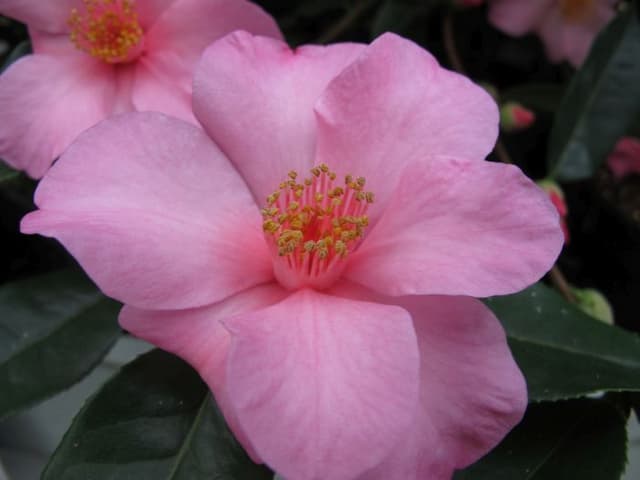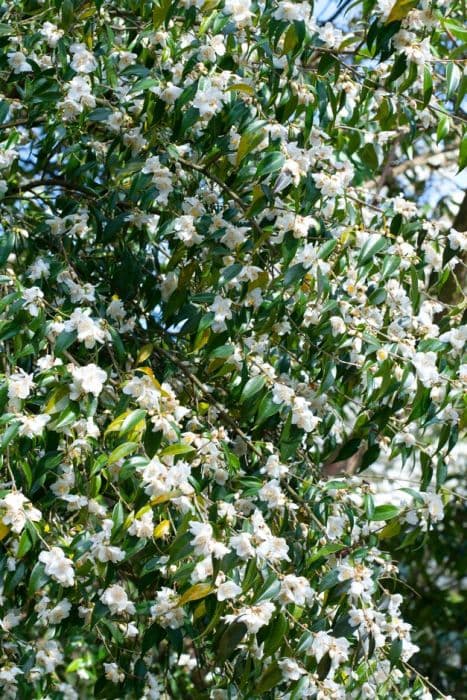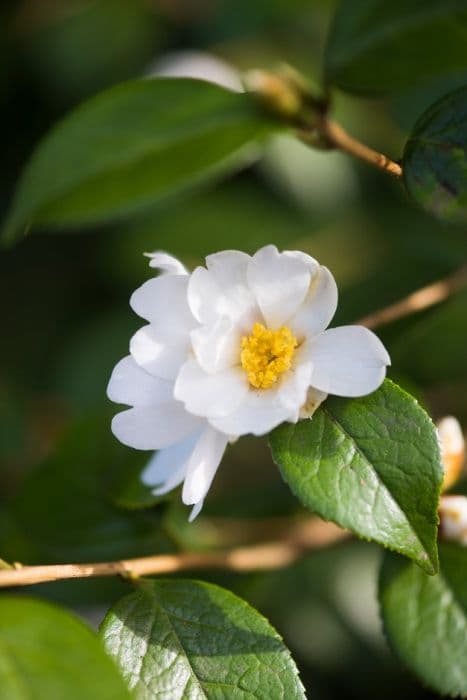Japanese Stewartia Stewartia pseudocamellia

ABOUT
Stewartia pseudocamellia, commonly known as the Japanese Stewartia, is a highly ornamental plant notable for its multi-season interest. The plant features a camellia-like white blossom with a cluster of yellow stamens at its center, typically flowering in summer. Each flower is cup-shaped and possesses a delicate, almost ephemeral beauty, with the petals arranged in a circular fashion. They are contrasted by dark green leaves that are elliptical or oval, with fine serrations along the edges, contributing to the textured appearance of the foliage. As the seasons change, the foliage of the Japanese Stewartia undergoes a remarkable transformation, showcasing a vivid array of autumnal colors, ranging from rich reds to deep oranges and purples. This creates a striking visual display that extends the plant's appeal beyond its blooming period. One of the most distinctive features of the Japanese Stewartia is its bark, which exfoliates in irregular patches to reveal a mosaic of colors underneath, including shades of gray, orange, and reddish-brown. This exfoliating bark adds significant winter interest, making the plant a focal point in the landscape even during the colder months. Overall, the Japanese Stewartia is appreciated for its beautiful flowers, colorful fall foliage, and unique, textured bark, which together create a year-round spectacle in the garden. Its aesthetic qualities make it a cherished addition where it can be admired across the changing seasons.
About this plant
 Names
NamesFamily
Theaceae
Synonyms
Japanese Stewartia, Korean Stewartia, Deciduous Camellia
Common names
Hartia pseudocamellia, Stewartia pseudocamellia var. koreana.
 Toxicity
ToxicityTo humans
The Japanese Stewartia is generally not considered toxic to humans. There are no well-documented cases or reports of poisoning from ingesting any part of this plant. As with any non-food plant, individual sensitivities or allergic reactions are possible but not commonly reported.
To pets
The Japanese Stewartia is not known to be toxic to pets either. It does not appear on common lists of plants that are poisonous to domestic animals such as cats and dogs. Standard caution should be exercised to prevent pets from ingesting large amounts of any non-food plants due to the potential for gastrointestinal upset or other non-toxic reactions.
 Characteristics
CharacteristicsLife cycle
Perennials
Foliage type
Deciduous
Color of leaves
Green
Flower color
White
Height
20-40 feet (6-12 meters)
Spread
15-25 feet (4.5-7.5 meters)
Plant type
Tree
Hardiness zones
5
Native area
Japan Korea
Benefits
 General Benefits
General Benefits- Ornamental Value: Korean Stewartia is known for its beautiful, camellia-like flowers that bloom in early summer, enhancing garden aesthetics.
- Seasonal Interest: With its peeling, multicolored bark, this plant offers visual interest in the winter landscape after the leaves have fallen.
- Autumn Foliage: The leaves of Korean Stewartia turn vibrant shades of red, purple, and orange in the fall, providing striking seasonal color.
- Shade Tolerant: Korean Stewartia can grow in partial shade, making it a versatile choice for garden spaces with varying light conditions.
- Wildlife Attraction: The flowers and fruit of the tree can attract birds and pollinators, promoting biodiversity in the garden.
 Medical Properties
Medical PropertiesThis plant is not used for medical purposes
 Air-purifying Qualities
Air-purifying QualitiesThis plant is not specifically known for air purifying qualities.
 Other Uses
Other Uses- Woodworking: The wood of Japanese Stewartia can be used in fine woodworking projects, such as for crafting small decorative objects or intricate inlays, owing to its hardness and fine grain.
- Photography Subject: Its striking flowers, interesting bark, and fall colors make Japanese Stewartia a favored subject for garden and nature photographers.
- Artistic Inspiration: The tree's distinctive bark pattern and overall aesthetic appeal can inspire artists in various media, from painting to textiles.
- Dye Production: The bark and leaves may be utilized to produce natural dyes for use in textile crafts, though this is less common.
- Bonsai: Japanese Stewartia can be cultivated as a bonsai specimen, where its small leaves and attractive flowers make it a coveted choice for enthusiasts.
- Wildlife Habitat: It provides shelter and nesting sites for birds, as well as supporting beneficial insects which are an integral part of healthy garden ecosystems.
- Landscape Photography Workshops: The tree's changing appearance through seasons makes it a great teaching tool for landscape photography courses, often serving as a subject for demonstrating various elements of composition and lighting.
- Educational Tool: Japanese Stewartia's various characteristics, such as its camellia-like flowers and non-native status, are often used in educational settings to teach about plant biology and adaptations.
- Wreath Making: Fallen leaves and seed pods can be collected and used in making natural wreaths and other decorative autumnal arrangements.
- Garden Structure Support: Mature trees can be used to support garden structures such as trellises or as natural 'poles' for climbing plants.
Interesting Facts
 Feng Shui
Feng ShuiThe Japanese Stewartia is not used in Feng Shui practice.
 Zodiac Sign Compitability
Zodiac Sign CompitabilityThe Japanese Stewartia is not used in astrology practice.
 Plant Symbolism
Plant Symbolism- Beauty: Stewartia pseudocamellia, commonly known as the Japanese Stewartia or Deciduous Camellia, typically symbolizes beauty due to its attractive camellia-like flowers that bloom in summer.
- Longevity: The bark of the Japanese Stewartia peels away in attractive patterns as it ages, symbolizing life's ongoing nature and longevity.
- Adaptability: With its ability to adapt to different soil types and conditions, the Japanese Stewartia symbolizes adaptability and versatility in life's changing circumstances.
- Uniqueness: The unique and textured bark, along with the distinct shape of its leaves and flowers, represent the idea of standing out and celebrating one's uniqueness.
 Water
WaterThe Japanese Stewartia requires consistent moisture and should be watered deeply when the top inch of soil feels dry, generally every week during the growth season. In the absence of rainfall, watering should be done in the early morning or late evening to reduce evaporation, providing about 1.5 gallons for small plants and up to 5 gallons for larger trees. During winter, reduce watering frequency, but ensure the tree doesn't dry out completely, especially for young trees which are less drought tolerant.
 Light
LightThe Japanese Stewartia thrives best in partial shade to full sun conditions. It should be planted in a location where it receives morning sun and afternoon shade, or dappled sunlight throughout the day to protect it from the harsh midday sun. An ideal spot is under the canopy of taller trees where it can receive filtered light.
 Temperature
TemperatureThe Japanese Stewartia does well in a range of temperature conditions but prefers a zone where the temperature stays between 60 and 80°F. It can tolerate winter temperatures down to about 0°F but may experience damage if exposed to temperatures below this. For best growth, avoid locations where temperatures frequently exceed 90°F.
 Pruning
PruningPruning the Japanese Stewartia is mainly necessary to remove dead or damaged wood and to shape the tree for aesthetic purposes. The best time for pruning is in late winter or early spring before new growth starts. Prune sparingly, as the tree has a naturally attractive shape, and too much pruning can detract from its beauty. Regularly check for and remove any suckers or unwanted branches.
 Cleaning
CleaningAs needed
 Soil
SoilJapanese Stewartia thrives in organically rich, acidic to neutral soil with a pH of 5.5 to 7.0. Ideal soil mix should contain equal parts of loamy soil, peat moss, and perlite or pine bark to ensure good drainage and aeration.
 Repotting
RepottingJapanese Stewartia, being a tree, is not typically repotted. Planting in the landscape should provide enough space for its roots to grow, and repotting is generally unnecessary unless growing in a container, which would be every 2 to 3 years.
 Humidity & Misting
Humidity & MistingJapanese Stewartia prefers moderate to high humidity levels but is adaptable to a range of conditions as long as the soil moisture is consistent.
 Suitable locations
Suitable locationsIndoor
Ensure bright, indirect light and room for growth.
Outdoor
Plant in partial shade with moist, well-draining soil.
Hardiness zone
5-8 USDA
 Life cycle
Life cycleStewartia pseudocamellia, commonly known as Japanese Stewartia, begins its life cycle when seeds germinate in moist, well-drained soil, preferably in partial shade. Seedlings emerge and grow slowly, establishing a deep taproot and producing a slender, upright stem. As the plant matures into a sapling, it develops a distinctive, somewhat pyramidal shape, and its bark starts to exfoliate, revealing a colorful, mottled pattern. Upon reaching maturity, which can take several years, the Japanese Stewartia produces white, camellia-like flowers in the summer that are pollinated by insects, setting the stage for seed development. The mature tree experiences an annual cycle of growth, flowering, and seed production, along with a striking display of reddish to purple leaf coloration in the fall before leaf drop. This deciduous tree's life cycle continues as it produces seeds that may be dispersed by wind or animals, propagating new plants and beginning the cycle anew.
 Propogation
PropogationPropogation time
Spring-Early Summer
The Korean Stewartia, or Stewartia pseudocamellia, is most commonly propagated by seed. The seeds require a period of cold stratification to break their dormancy, a process that can be achieved by placing them in a mixture of moist sand and peat in a plastic bag and refrigerating it typically for about 3 months. After stratification, the seeds can be sown in a well-draining soil mix, lightly covered, and kept moist. Germination could take several weeks, and it is important to protect the young seedlings from too much direct sunlight. This method of propagation requires patience, as it may take several years for seed-grown Stewartias to flower and achieve their full ornamental potential.









